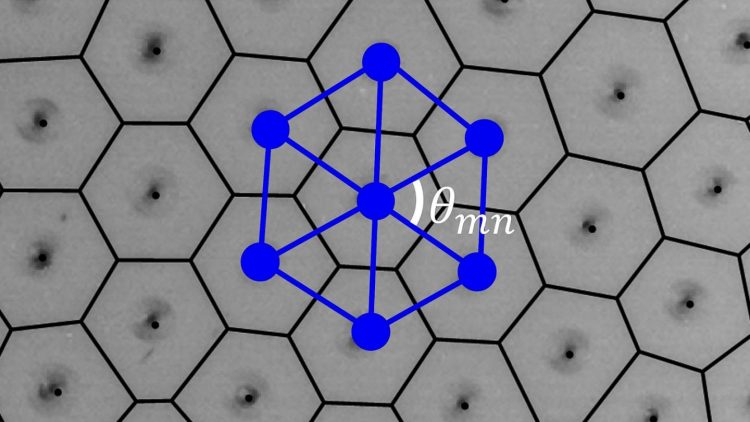Argonne researchers create active material out of microscopic spinning particles

Self-assembled dynamic lattice of spinners. The Voronoi diagram is overlaid with the observed lattice. The spinners are blurred because of the long exposure time that enabled precise identification of the rotational axes for all spinners. Credit: Argonne National Laboratory
These so-called active materials contain small magnetic particles that self-organize into short chains of particles, or spinners, and form a lattice-like structure when a magnetic field is applied.
“Active materials need an external energy source to maintain their structure,” said Argonne materials scientist Alexey Snezhko, an author of the study.
“The interesting thing is that you can have these very quickly rotating structures that give the appearance of a yet larger system that is still, but it remains quite active.” — Argonne materials scientist Alexey Snezhko
Unlike in previous experiments involving active materials, which looked at particles that demonstrated linear motion, these new spinners acquire a handedness — like right- or left-handedness — that causes them to rotate in a specific direction.
This twirling rotation of the suspended self-assembled nickel spinners creates a whirlpool-like effect, in which different particles can get sucked in to the vortices created by their neighbors.
“The particles don't move on their own, but they can be dragged around,” Snezhko said. “The interesting thing is that you can have these very quickly rotating structures that give the appearance of a yet larger system that is still, but it remains quite active.”
As the particles start to come together, the whirlpools created by the spinning motion — in conjunction with the magnetic interactions — pull them even closer, creating a fixed crystalline-like material, even as the spinners still rotate.
The Argonne researchers wanted to know how a non-spinner particle would be transported through the active lattice. According to Snezhko, the rapid whirling of the spinners creates the ability for these other cargo particles to move through the lattice much more quickly than they would through a normal material. “In regular diffusion, the process of getting a particle from one side of the material to the other is temperature-dependent and takes a much longer period of time,” he said.
The transport of a non-spinner particle is also dependent upon the spacing between the spinners. If the spinners are located sufficiently far apart, the non-spinner particle will travel chaotically between different spinners, like a raft traveling down a series of whitewater rapids. If the particles in the lattice come closer together, the non-spinner particle can become trapped in an individual cell of the lattice.
“Once the particle comes within a cell through its own chaotic motion, we can modify the field so that the lattice slightly shrinks, making the probability of the particle to leave that location in the lattice very low,” Snezhko said.
The material also showed the ability to undergo self-repair, similar to a biological tissue. When the researchers made a hole in the lattice, the lattice reformed.
By looking at systems with purely rotational motion, Snezhko and his colleagues believe that they can design systems with specific transport characteristics. “There are many different ways for getting an object in a material from point A to point B, and this type of self-assembly could be tailored for different dynamics,” he said.
###
A paper based on the study, “Reconfigurable structure and tunable transport in synchronized active spinner materials,” appeared in the March 20 issue of Science Advances.
The study was funded by DOE's Office of Science. Other authors of the paper included Argonne's Koohee Han and Gasper Kokot, as well as Shibananda Das, Roland Winkler, and Gerhard Gompper of the Forschungszentrum Jülich in Germany.
Argonne National Laboratory seeks solutions to pressing national problems in science and technology. The nation's first national laboratory, Argonne conducts leading-edge basic and applied scientific research in virtually every scientific discipline. Argonne researchers work closely with researchers from hundreds of companies, universities, and federal, state and municipal agencies to help them solve their specific problems, advance America's scientific leadership and prepare the nation for a better future. With employees from more than 60 nations, Argonne is managed by UChicago Argonne, LLC for the U.S. Department of Energy's Office of Science.
The U.S. Department of Energy's Office of Science is the single largest supporter of basic research in the physical sciences in the United States and is working to address some of the most pressing challenges of our time. For more information, visit https:/
Media Contact
All latest news from the category: Materials Sciences
Materials management deals with the research, development, manufacturing and processing of raw and industrial materials. Key aspects here are biological and medical issues, which play an increasingly important role in this field.
innovations-report offers in-depth articles related to the development and application of materials and the structure and properties of new materials.
Newest articles

Scientists transform blood into regenerative materials
… paving the way for personalized, blood-based, 3D-printed implants. Scientists have created a new ‘biocooperative’ material based on blood, which has shown to successfully repair bones, paving the way for…

A new experimental infection model in flies
…offers a fast and cost-effective way to test drugs. Researchers at the Germans Trias i Pujol Research Institute and Hospital have reinforced their leading role in infectious disease research by…

Material developed with novel stretching properties
KIT researchers produce metamaterial with different extension and compression properties than conventional materials. With this material, the working group headed by Professor Martin Wegener at KIT’s Institute of Applied Physics…



